Margaux Durand-Rival explained to us the work of The Third Floor on EDGE OF TOMORROW in 2014. She then worked on numerous projects such as DRACULA UNTOLD, PADDINGTON, EXODUS: GODS AND KINGS and MISSION IMPOSSIBLE: ROGUE NATION.
How did you get involved on this show?
I had just finished working on MISSION IMPOSSIBLE: ROGUE NATION when my studio manager at The Third Floor London, Duncan Burbidge, told me about the project. Barry Howell, founder and supervisor from The Third Floor in L.A., was going to be the previs supervisor on the show, and he needed a strong lead/co-supervisor from London as the team would be London based. I didn’t have to think about it twice, and immediately said “Yes!”
What was your feeling to be in the Star Wars universe?
I was a bit nervous at first, as I love the STAR WARS world and of course I’ve seen all the movies many times, but I’m not an absolute “geek” about it. I was pretty sure everyone involved on the show would know everything about every single ship, or character, or planet and so on… and it was kind of true! Colin Goudie, the editor on the film who worked with us during the previs phase, had the craziest editing room ever, full of STAR WARS toys and goodies! Being part of a STAR WARS movie is a sort of honor when you know how many people are so into it, so I did my homework and tried to learn as much as I could to be up to date when I started on the show. Best homework ever!
How was your collaboration with director Gareth Edwards?
Working with Gareth Edwards was pretty amazing. He has a visual effects artist background so he totally understands previs and how to use it. He can sit next to you while you are working and even grab the mouse to navigate himself in the scene to explain what he wants to see, which is quite unusual for a director. This approach allows us to propose a lot of interactive options, such as using a virtual camera to shoot a scene, for instance. He had such a strong vision that he usually only had to describe what he wanted for a scene and we could clearly see what we had to do to make it work.
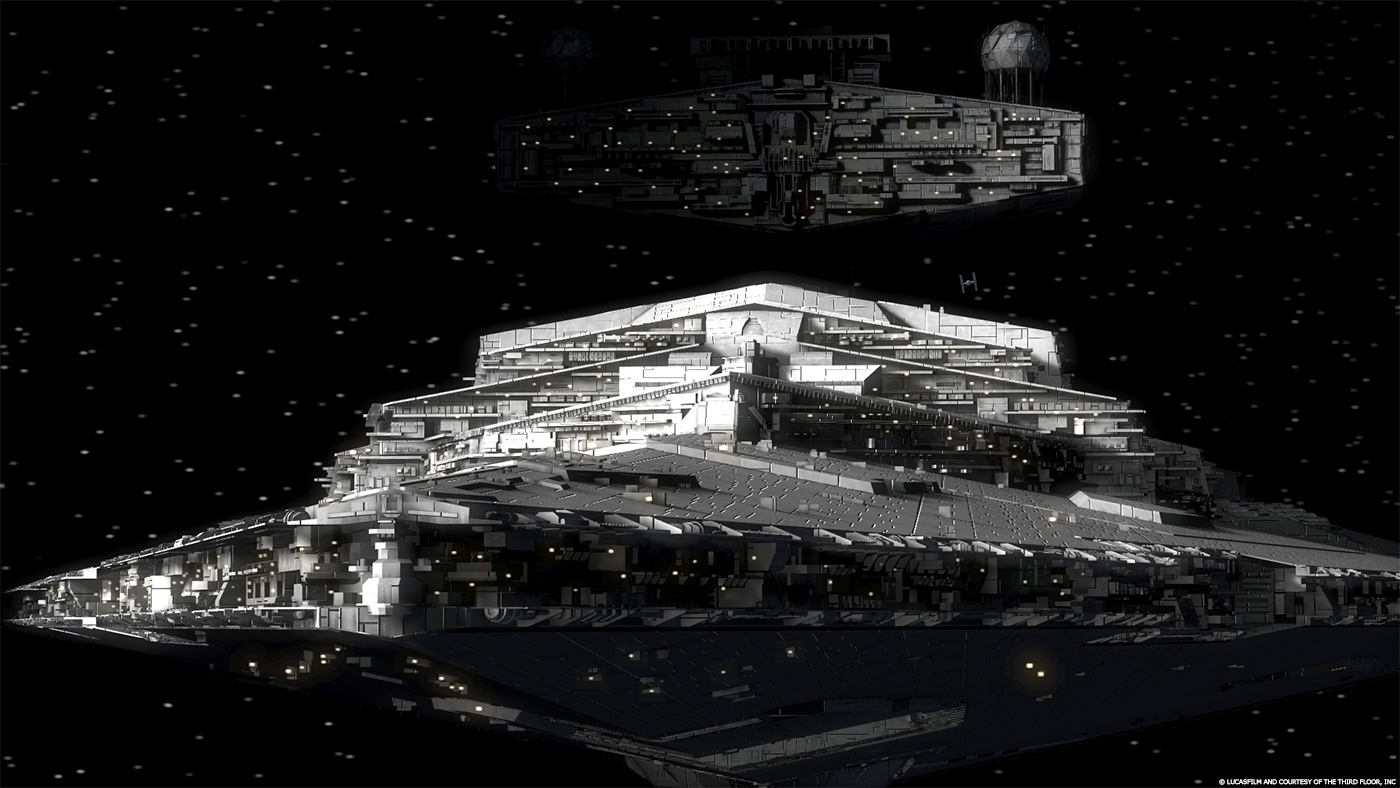
What was his approach and expectations about the previs?
He has the clever approach to know that once he will be on set, he will probably explore the shots and find other angles, or think of something new. So the previs for him was more a blueprint than something that he would follow perfectly. But it allowed him to explore a lot of different options and also show those ideas to his crew and the producers. He really wanted the previs to look polished in terms of animation, lighting and effects in order to feel the mood he wanted for every sequence, like the scenes on Eadu, for instance, which was very rainy and foggy. For everything that was going to be full CG or CG heavy, he wanted us to do a version so he could do a number of iterations on those shots before they went to ILM.
What kind of direction and style did he give to you?
Gareth wanted two key things: he wanted the battles to feel quite handheld, a bit “guerrilla” style, as he likes to grab the camera himself, but he wanted the other shots to be the opposite — very still and majestic. He liked the cinematic style from 80s films like ALIEN from Ridley Scott and ALIENS from James Cameron. Those were our main references for the Eadu sequence, but for the Third Act on Scarif, our references were more from war movies, especially the Vietnam War and motion pictures like APOCALYPSE NOW and PLATOON. For the space sequences, his main priority was always to feel the scale, which is very important in space as you can easily get lost by the lack of reference of speed, scale and distance. So he liked to utilize references that one would immediately know to make things massive. He did it beautifully when the Death Star is revealed for the first time. First we follow a Tie Fighter, to reveal a Star Destroyer that seems huge compared to the Tie, and then this Destroyer reveals an even more massive object, the Death Star, and seems tiny in comparison.
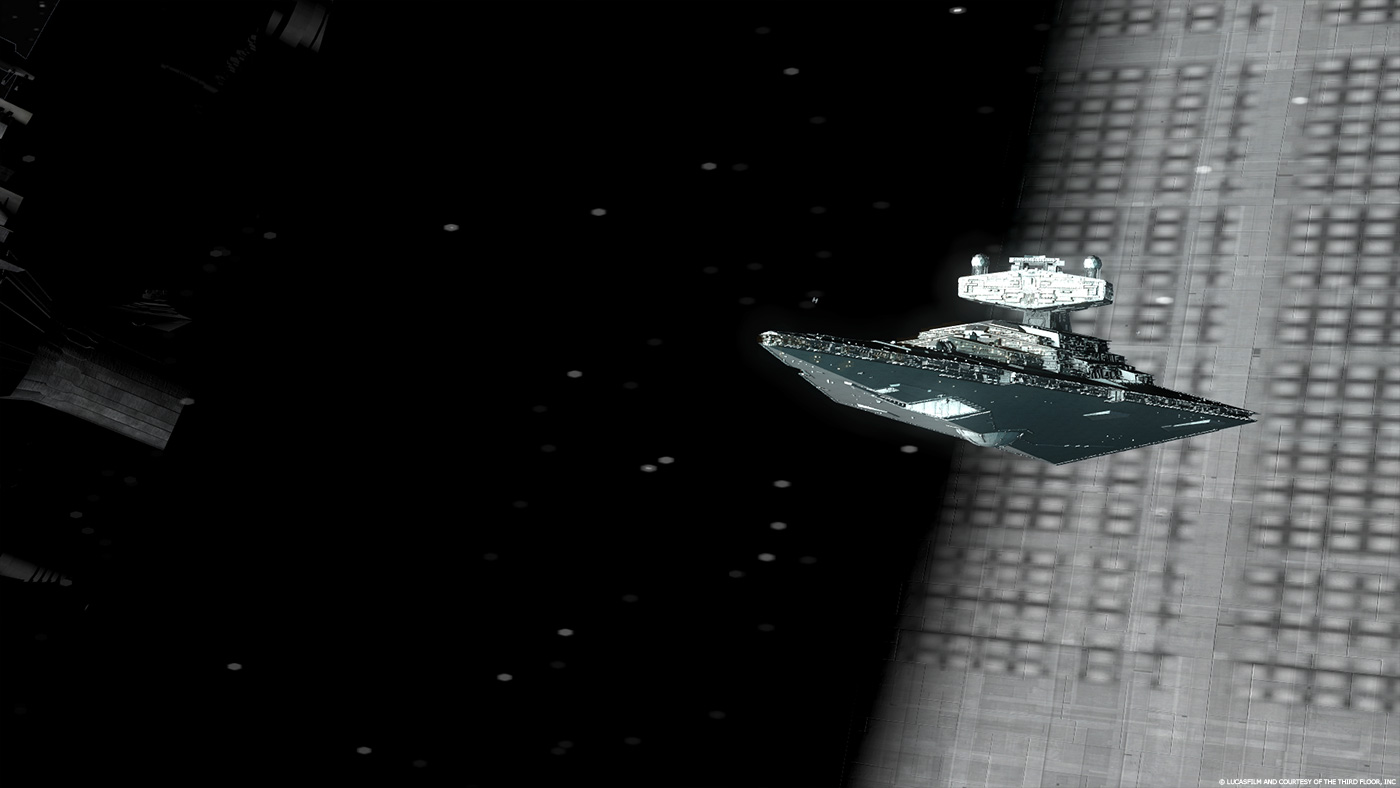
Did you receive specific indications or references for the animation?
We didn’t have many creatures to animate in previs. Most of the animation in previs was animating human characters and ships, which was quite easy to do with all the reference we had from the other movies. As ROGUE ONE takes place just before EPISODE IV, it shares the same universe so we were able to watch the movies again to mimic the AT-AT animation for the Scarif sequence, for instance. One specific character we had was K2SO, but at the previs stage he was still being designed in terms of animation style, so we animated him as a mix of a human being and droid, knowing he would ultimately be based around motion capture and final CG from the vfx side.
How did you work with John Knoll and the VFX supervisors of ILM?
It was a great collaboration to work with John Knoll and Mohen Leo from ILM in previs initially, then during the shoot and then in postvis. They were clear from the start that we had to be very accurate with our previs and never cheat anything, so they wouldn’t end up with scenes that couldn’t be properly created in post production or on the day while they were on set. This is what we do all the time but we were extremely careful in this case, especially with some sequences like the Jedha scenes, which were quite tricky because of the scale of the destruction. We often worked hand to hand with ILM to create interactive content, like previs environments that were projected on giant wrap-around LED screens during the shoot, or on animated scenes that were used for the ILM virtual camera for various sequences, mostly the Space Battle. It was a great experience to be able to work with a legend like John Knoll and have his input on our work as well.

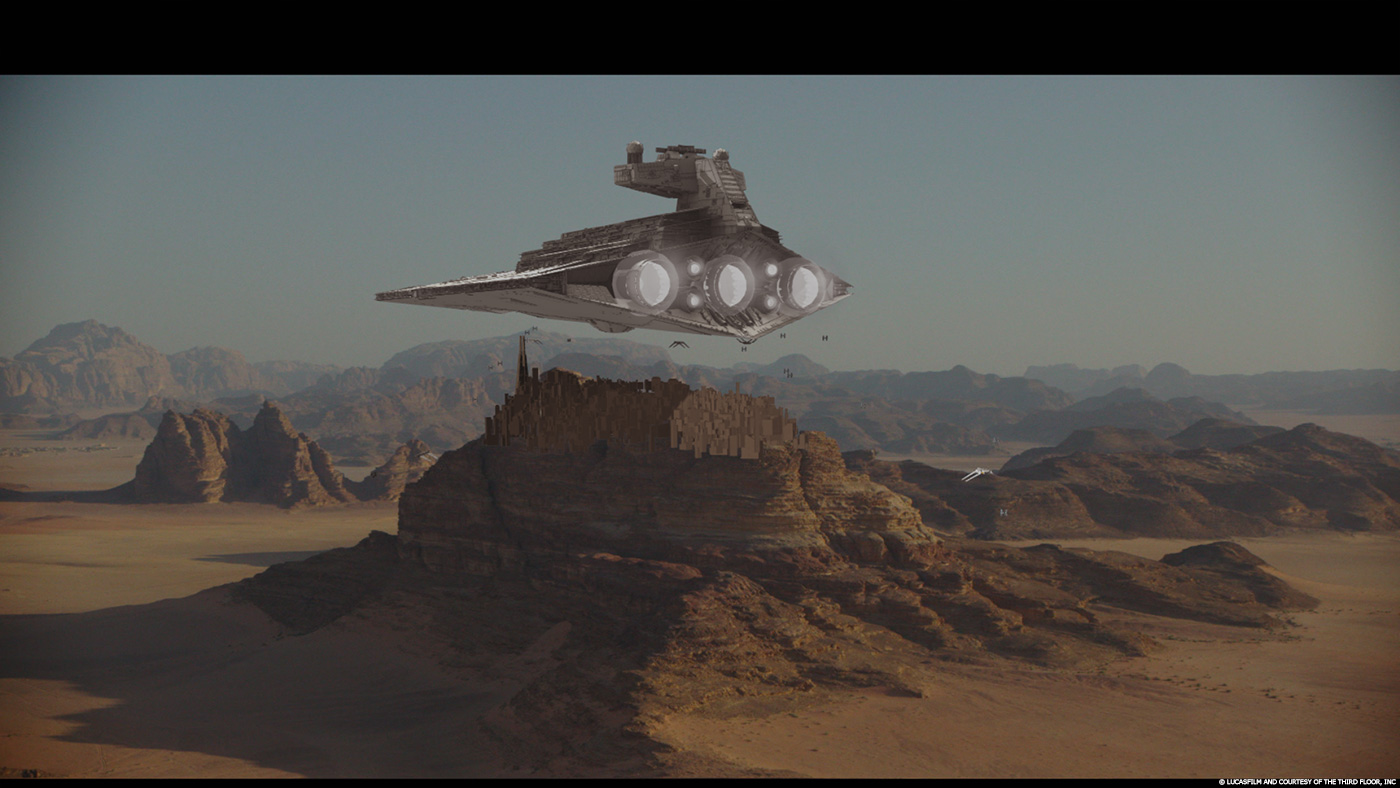
How was the work organized at The Third Floor?
Our work spanned more than a year and a half, supervised by Barry Howell at first, then by myself, and finally by The Third Floor’s Jason Wen, who guided our efforts on the project to the end of postvis. During previs, the team was mostly composed of a number of six very strong shot creators, including Barry and me, doing staging, animation, camera work, lighting and FX work for previs, along with two previs asset builders, who handled modeling, rigging and texturing of all the previs assets. In postvis, we had an average of six artists, doing tracking, compositing and animation.
What kind of freedom did you have to propose ideas?
We had quite a lot of freedom. We were working very closely with two amazing storyboard and concept artists, Matt Allsopp and Jon McCoy. They were drawing some of the most incredible storyboards I’ve ever had the chance to work with that were more like “keyframes” than storyboards that told you the camera action. Every frame had a strong composition, which is very important for Gareth, as well as lighting information. But for every keyframe, we had to visualize what the camera was doing, which was great. It was our job to think about all the references of style Gareth has given us, and imagine “What would he do on this one?” And Gareth was very open minded about new ideas. He would often ask us to propose different options and was keen on having our input in the movie. For him, we were working as a team, trying to make the best movie possible, so every time we thought of something that could improve the shot, he wanted to hear about it.
How did you work with ILM to visualize the various iconic vehicles?
For the new vehicles, we were mostly working with the art department to receive their design blueprints and they would often do rough CG versions of those ships. Our coordinator, Craig Skerry, would track down those new assets so we could put them in the previs as early as possible to see how they felt in terms of scale, speed and animation. The U-Wing is a great example, as it is used in a lot of sequences, so we had to test it to be sure that it was working well in terms of what one could see from the cockpit, what we see when the side door opens, if there was enough space in the cargo hold to fit everyone and so on.
For the other iconic vehicles from STAR WARS history, ILM provided us with most of the models, which we would then optimize for our previs pipeline, which requires light assets so we can stay in real time as much as possible.
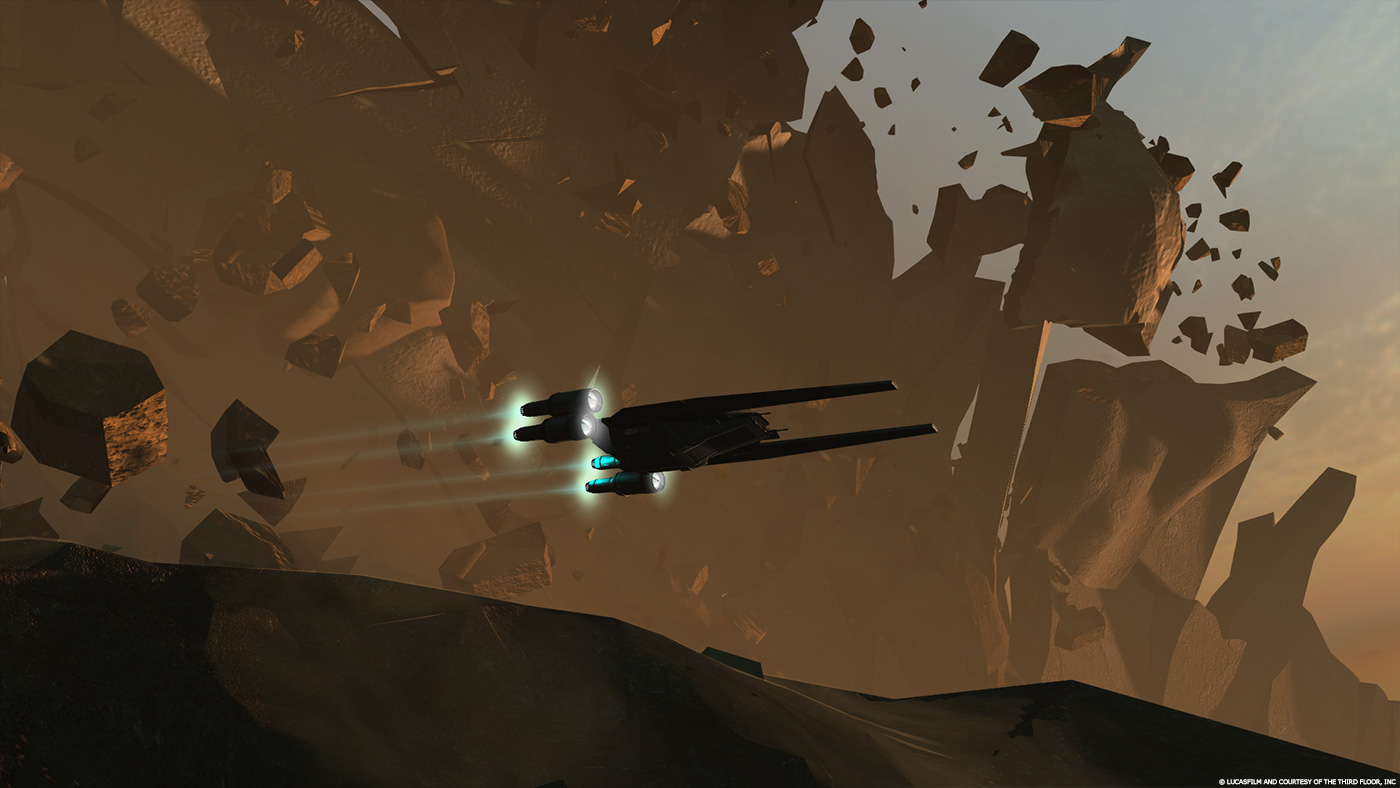
Which character or vehicle was the most fun to animate and why?
It was really cool to animate K2SO very early in the project. When you work in previs, you don’t have a performance from an actor or voice to follow at such an early stage and, in this case, it was a character that speaks but doesn’t have a mouth. We thought very early that they might play later on with the light in his eyes when he talks, which was in the end the only way in our “silent” previs to tell that he was interacting with the other characters. The final performance by Alan Tudyk is quite subtle compare to what we animated in the previs, where we had to move his arms and hands a lot more. The character’s scale was also very tricky, as K2SO is so tall in comparison with everyone else. We needed to frame the previs shots so he fit nicely without being crouched all the time.
Can you describe your approach before creating a shot or sequence?
When we started a sequence, I liked to take the time to divide it into different action beats so we could clearly see which actions needed strong continuity. It also makes it easier when you are dividing the work within your team, as we try to give small sequences to each artist so they can work their shots in continuity. We can then create “master scenes” that have a big section of continuous action, as well as nice lighting and mood, and then create all the shots of the sequence in the same scene as a starting point. For each sequence, we always take the time to find as much reference as we need from storyboards, concept art, costume designs, etc. but also other existing movies, and of course we talk with the director about their approach on the sequence, what is important, and how they want it to look.
Which sequence was the most complicated?
We had a few tricky sequences, like the Jedha Destruction scene, but one of the most complicated was the Space Battle, as we had to provide a lot of possible coverage for virtual camera. The virtual camera is a device that allows directors to be “inside” a computer-generated environment and to frame the action “live” exactly as they would do if they were on a real set. They look through a screen that is the size of a tablet and can orient that to look around or move around physically in the environment to choose the best point of view. To support this work, we had to create five very long chunks of animation for the different beats of the sequence in real time, with all the space battle going on and dozens of ships fighting each other, knowing that it had to look good from every possible point of view! A single change of timing for one event, and it had a ripple effect on the whole scene, forcing us to adjust the timing of everything else… It is very different from working a sequence on a shot basis, where you can animate only what is in front of your camera. Because each section of animation had to be in one continuous animated scene, we had to give each scene to one artist only, which was very challenging for them!
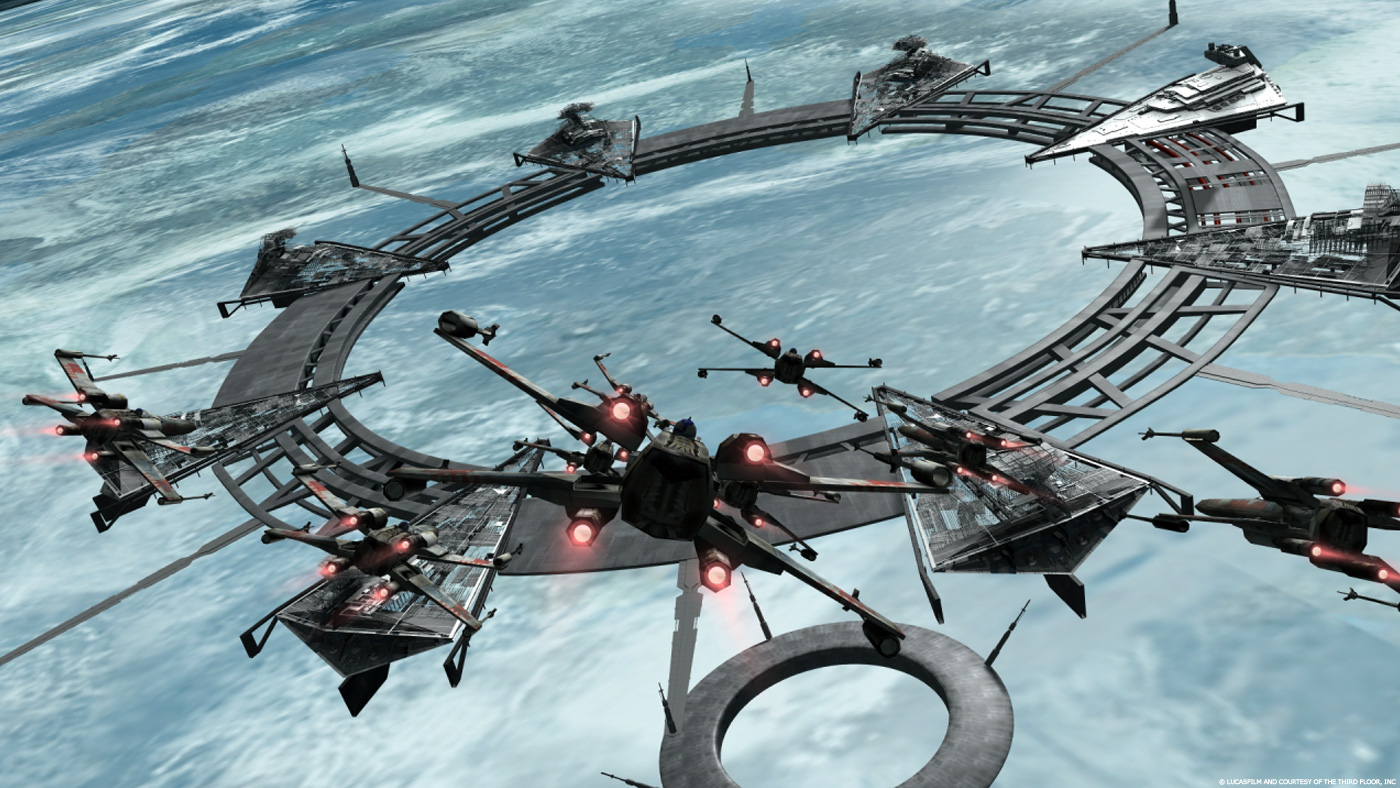
Can you tell us more about the postviz process?
We started the postvis quite early, even during the shoot, doing some test shots with Barry, but it really kicked off when the shoot was completed. We worked in the editorial suite with Gareth, all the editors and assistants and ILM London supervisor Mohen Leo, and we shared the postvis work with visual effects house Jellyfish Pictures, who focused on the heavy 2D work. Basically, we would grab the takes selected by Gareth and the editors, track them, put our animated previs elements into the shot and composite them, so we could have a first version of what the final shot would look like. It is a very interesting process, where you are able to solve a lot of the problems early in the process with a very quick turnover. Do the CG elements fit into the shot, do we have time to “read” the animation, does it look nice? We were able to serve as a link between Gareth and ILM, helping develop the desired shots, with advice from the VFX supervisor about what could and couldn’t be done with the assets and so on.
What was your favorite moment on the show?
It is always very nice when the shoot starts and you can come to the set and finally see work that was done in pre-production coming to life. But otherwise I think the nicest moment was during postvis, when the first trailer of the movie was released. All the team gathered with Gareth and the editors, producers and ILM in front of the screen to watch it live. And then we spent a bit of time together reading aloud all the comments we could find on the social networks, and watching the first YouTube reactions. It was very emotional to be together at this moment and see all the fans going crazy about it!
Was there a shot or a sequence that prevented you from sleeping?
Personally, I would say the Jedha Destruction scene. On my first day on the project, it was my assignment from Barry. “We have a sequence where the Death Star fires on a planet and we experience the destruction from the ground as the heroes try to escape on a ship,” he said. “Try to come up with something. Oh, and make it a single animated take if possible, just in case we want to use the virtual camera system for this sequence later on!”
I think I had a few pieces of concept art to work with, and that was it. I can remember myself watching my empty 3D scene, with not a single asset to work with, and no idea where to start. I ended up doing research for a while, just to test out the scale of the destruction in a realistic way. It kept me awake at night for a bit, but we were able to develop a nice setup that we used multiple times, with one animation for the whole destruction from start to finish and a lot of effects like smoke and debris, which looked pretty decent for something real time!
What do you keep from this experience?
So many nice memories, as it was the most exciting project I’ve ever worked on, but also because we had the chance to work with amazing artists. Every stage in Pinewood was like a treasure box, from the costumes department to the creatures workshop, and everyone was happy to share their knowledge and to work together as well. Working with Gareth was also truly amazing as he had such a strong vision of the movie he wanted to do, and it was great to work with ILM and all the other departments to fulfill that vision.

A big thanks for your time.
// WANT TO KNOW MORE?
– The Third Floor: Official website of The Third Floor.
© Vincent Frei – The Art of VFX – 2017






